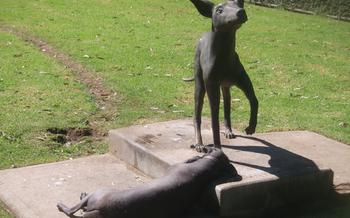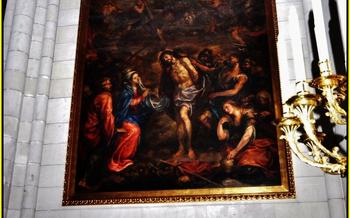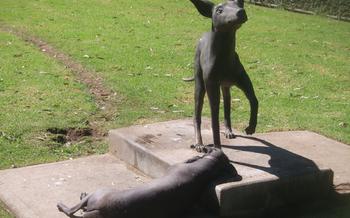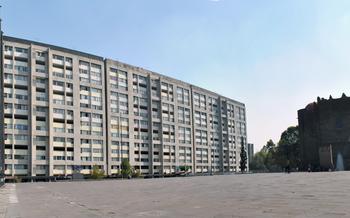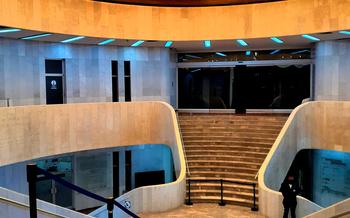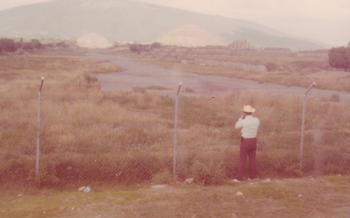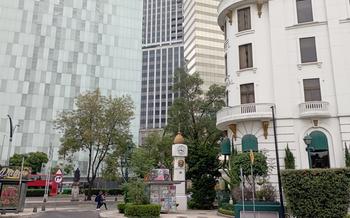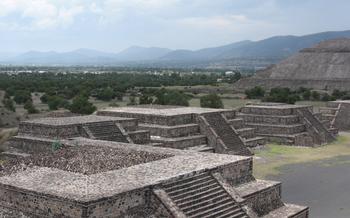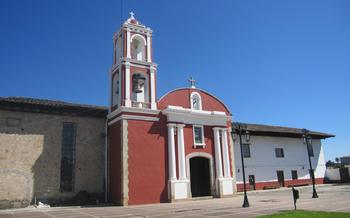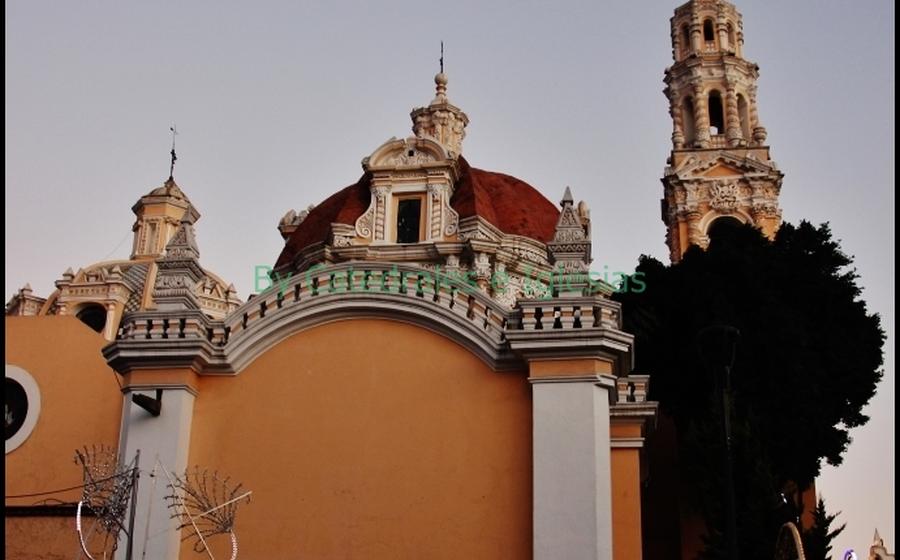
Museo de los Dolores Olmedo
- Exploring the Museum's Collection
- The Legacy of Dolores Olmedo: A Passionate Collector
- Xochimilco's Floating Gardens: A Natural Paradise
- Frida Kahlo's Casa Azul: A Journey into Her Life
- Puebla's Culinary Delights: A Feast for the Senses
- Exploring Puebla's Historic Center: A UNESCO World Heritage Site
- Visiting the Talavera Workshops: A Colorful Tradition
- Adventurous Day Trips from Puebla
- Local Markets and Handicrafts: A Treasure Trove of Culture
- The Magic of the Pueblan Nights: Festivals and Celebrations
- Practical Tips for a Smooth Visit: Transportation and Accommodation
- Insider Tip: Unveiling Hidden Gems
Exploring the Museum's Collection
The Museo de los Dolores Olmedo houses a diverse collection of pre-Columbian artifacts, Diego Rivera's murals, Frida Kahlo's self-portraits, and artworks by other renowned Mexican and international artists.
Among the pre-Columbian highlights are intricate sculptures, pottery, and ceremonial objects from various ancient Mesoamerican cultures. These artifacts provide a glimpse into the rich artistic traditions and craftsmanship of Mexico's indigenous peoples.
Diego Rivera's murals, displayed in a dedicated gallery, showcase his iconic style and commitment to social and political themes. His vibrant and large-scale works often depict scenes from Mexican history, the struggles of the working class, and the beauty of the Mexican landscape.
Frida Kahlo's self-portraits and surrealist paintings form a significant part of the collection. Her deeply personal and emotional works explore themes of identity, pain, love, and the female experience. Her unique style, characterized by vibrant colors and symbolic imagery, has captivated audiences worldwide.
In addition to these iconic artists, the museum also features works by other Mexican masters such as José Clemente Orozco, David Alfaro Siqueiros, and Rufino Tamayo. International artists like Pablo Picasso, Joan Miró, and Salvador Dalí are also represented, showcasing the museum's commitment to promoting a diverse range of artistic expressions.
The Legacy of Dolores Olmedo: A Passionate Collector
Dolores Olmedo, a renowned figure in the Mexican art world, played a pivotal role in preserving and promoting the country's cultural heritage. Her passion for collecting and her personal relationships with renowned artists, especially Diego Rivera and Frida Kahlo, led to the creation of the Museo de los Dolores Olmedo. This remarkable institution showcases a diverse collection that reflects Olmedo's discerning taste and her unwavering commitment to Mexican art.
Olmedo's deep admiration for Rivera and Kahlo extended beyond their artistic brilliance to their shared commitment to social justice and Mexican identity. She forged a close friendship with both artists, becoming a confidante and a source of support throughout their lives.
Olmedo's vision for the museum was to create a space where the works of Rivera, Kahlo, and other Mexican and international artists could be appreciated and studied by future generations. Her generosity and foresight resulted in the establishment of a world-renowned institution that has become a cornerstone of Puebla's cultural landscape.
Anecdotes abound about Olmedo's dedication and her tireless efforts to acquire significant artworks. One such story tells of her determination to obtain a particular painting by Rivera, which was in the possession of a reluctant collector. After several unsuccessful attempts to purchase the painting, Olmedo arranged for a truckload of fresh produce to be delivered to the collector's ranch as a gift. The gesture softened the collector's heart, and he eventually agreed to part with the painting, recognizing Olmedo's genuine appreciation for Rivera's work.
Through her unwavering commitment to preserving Mexican art and culture, Dolores Olmedo left a lasting legacy that continues to inspire and educate visitors to the Museo de los Dolores Olmedo. Her passion and generosity have ensured that the works of Rivera, Kahlo, and other great artists will continue to be cherished and celebrated for generations to come.
Xochimilco's Floating Gardens: A Natural Paradise
Xochimilco's chinampas, a network of man-made islands and canals, offer a unique blend of natural beauty and cultural heritage. Rooted in ancient Aztec farming practices, these floating gardens have been meticulously cultivated for centuries, showcasing sustainable agriculture techniques that harmonize with the delicate ecosystem.
Embark on a scenic boat ride through the tranquil canals, surrounded by lush vegetation, colorful flowers, and the gentle sound of water. Marvel at the ingenuity of the chinampa farmers as they tend to their crops, using traditional methods passed down through generations.
Immerse yourself in the vibrant local culture as you pass by traditional markets and food stalls, offering a tempting array of fresh produce, local delicacies, and handcrafted souvenirs. Engage with the friendly vendors and learn about their way of life, rooted in the traditions of Xochimilco.
Discover the historical significance of these floating gardens, which played a crucial role in providing food and resources to the Aztec capital of Tenochtitlan. Xochimilco's chinampas are a testament to the resilience and creativity of the local communities, who have preserved this unique agricultural system for centuries.
Indulge in a culinary adventure at one of the many restaurants along the canals, savoring the flavors of traditional Mexican dishes prepared with fresh ingredients harvested from the chinampas. As you dine amidst the tranquil surroundings, let the beauty of Xochimilco's floating gardens transport you to a world where nature and culture intertwine.
Frida Kahlo's Casa Azul: A Journey into Her Life
The Blue House, located in the vibrant neighborhood of Coyoacán, is a must-see for anyone interested in the life and work of Frida Kahlo. This iconic home, where Kahlo lived for many years, has been transformed into a museum that offers a unique glimpse into her personal world.
Wandering through the rooms of the Casa Azul is like stepping back in time. Kahlo's personal belongings, artwork, and mementos are carefully preserved, providing visitors with an intimate look into her daily life, struggles, and creative process. From her vibrant paintings to her colorful clothing and traditional Mexican handicrafts, every corner of the house reveals a piece of her extraordinary personality.
One of the highlights of the museum is Kahlo's bedroom, where she spent many hours painting and recovering from her numerous health issues. The bed is surrounded by mirrors, reflecting her preoccupation with self-portraiture and her fascination with her own image.
Visitors can also explore the garden, where Kahlo found solace and inspiration. Filled with lush vegetation and traditional Mexican plants, the garden was a place where she could escape the chaos of the city and connect with nature.
The Casa Azul is not just a museum; it's a living testament to the indomitable spirit of Frida Kahlo. Through her personal effects and artwork, visitors can gain a deeper understanding of her life, her art, and her enduring legacy as one of the most influential artists of the 20th century.
Puebla's Culinary Delights: A Feast for the Senses
Puebla, renowned for its rich gastronomy, offers a tantalizing array of culinary experiences guaranteed to delight your palate.
Indulge in traditional Poblano dishes such as mole poblano, a complex sauce made with chiles, spices, and chocolate, often paired with chicken or turkey. Chiles en nogada, a dish consisting of poblano peppers stuffed with picadillo, fruits, and nuts, topped with a walnut cream sauce and pomegranate seeds, is another must-try.
Street food in Puebla is not to be missed. Sample tacos al pastor, succulent pork cooked on a vertical spit and served in tortillas with pineapple, onions, and cilantro. Cemitas, a type of sandwich made with sesame-seed bread, filled with meat, avocado, and cheese, are another local favorite.
Puebla's culinary scene is diverse, offering options for every taste. From traditional markets to fine-dining restaurants, there's something to satisfy every foodie's cravings.
Insider Tip:
For a unique culinary experience, visit the Calle de los Dulces (Street of Sweets). This street is lined with shops selling traditional Mexican candies, including camotes, sweet potato candies, and borrachitos, fruit-flavored candies soaked in alcohol.
Exploring Puebla's Historic Center: A UNESCO World Heritage Site
Puebla's historic center, a UNESCO World Heritage Site, is a captivating fusion of architectural wonders and cultural heritage. Stroll along the cobblestone streets, admiring the intricate facades of colonial-era buildings, churches, and mansions. Gaze upon the grandeur of the Puebla Cathedral, its twin towers reaching towards the sky. Explore the Zócalo, the city's main square, where history unfolds amidst bustling cafes and street performers.
Discover the Talavera tiles adorning buildings, a unique ceramic art form that adds vibrant colors to the cityscape. Visit the impressive Biblioteca Palafoxiana, one of the oldest libraries in the Americas, and immerse yourself in its collection of rare books and manuscripts.
Immerse yourself in the vibrant atmosphere of the city's markets, where vendors display an array of traditional handicrafts, textiles, and delicious local delicacies. Join the locals in celebrating one of the many festivals that take place throughout the year, where music, dance, and colorful processions fill the streets.
Puebla's historic center is a living museum, where the past and present intertwine to create a truly unforgettable experience.
Visiting the Talavera Workshops: A Colorful Tradition
Puebla is renowned for its exquisite Talavera pottery, a vibrant and intricate art form that has earned international recognition. Visiting the Talavera workshops in Puebla offers a unique opportunity to witness the skillful craftsmanship and artistry behind these beautiful creations.
These workshops have been in operation for centuries, preserving and passing down traditional techniques from generation to generation. Visitors can observe artisans meticulously molding clay, applying intricate designs, and glazing each piece with vibrant colors. The workshops often offer hands-on demonstrations and workshops, allowing visitors to try their hand at creating their own Talavera pieces.
Strolling through the workshops, one can admire the vast array of Talavera products, from decorative tiles and tableware to vases, sculptures, and more. The vibrant colors and intricate patterns are a testament to the skill and creativity of the artisans. Visitors can purchase unique souvenirs and gifts, supporting the local artisans and taking a piece of Puebla's cultural heritage home with them.
In addition to the workshops, visitors can also explore the Talavera Museum in Puebla, which showcases a comprehensive collection of historical and contemporary Talavera pieces. The museum provides insights into the history, techniques, and evolution of this beloved art form.
Exploring the Talavera workshops and the Talavera Museum is a must for anyone interested in Mexican culture, art, and craftsmanship. These vibrant workshops offer a glimpse into the creative process behind these beautiful ceramics, allowing visitors to appreciate the skill and dedication of the artisans who keep this tradition alive.
Adventurous Day Trips from Puebla
Puebla offers a rich tapestry of experiences beyond its city limits, inviting travelers to embark on captivating day trips to neighboring destinations. Among these, two stand out as must-visit attractions.
First, the ancient city of Cholula, located just a short drive from Puebla, boasts the awe-inspiring Great Pyramid, the largest in the world by volume. This colossal structure, built over centuries by pre-Columbian civilizations, offers a glimpse into Mexico's rich history and architectural prowess. Ascending the pyramid's many steps rewards visitors with breathtaking panoramic views of the surrounding valley.
For a unique wildlife experience, Africam Safari Park, situated about an hour from Puebla, provides an immersive encounter with exotic animals from around the globe. Embark on a thrilling safari tour, observing majestic lions, graceful giraffes, and playful zebras roaming freely in spacious enclosures. The park also offers educational exhibits, interactive shows, and opportunities for close-up encounters with some of the animals.
Beyond these two popular destinations, Puebla's surrounding region is dotted with charming magical towns, each with its own unique character and attractions. Atlixco, known for its colorful murals and vibrant flower markets, is a delightful destination for those seeking a picturesque escape. Tlaxcala, the capital of the neighboring state, offers a rich blend of colonial architecture, indigenous traditions, and culinary delights.
Venturing beyond Puebla's city limits promises unforgettable experiences, whether exploring ancient ruins, encountering exotic wildlife, or discovering the hidden gems of traditional Mexican towns.
Local Markets and Handicrafts: A Treasure Trove of Culture
Puebla's vibrant markets are a testament to the city's rich cultural heritage and artisanal traditions. The Mercado del Parian stands as a must-visit destination, where colorful stalls overflow with intricate Talavera pottery, handwoven textiles, and traditional clothing. Shoppers can immerse themselves in the lively atmosphere, haggle for unique souvenirs, and witness the skilled craftsmanship of local artisans.
Beyond the Parian Market, Puebla's streets are lined with specialty markets, each offering a diverse array of goods. The Mercado de Artesanías El Parián showcases a wide selection of handmade crafts, including intricate silver jewelry, blown glass, and traditional Mexican toys. The Mercado de los Dulces tempts visitors with an array of delectable sweets, from traditional candies to artisanal chocolates, while the Mercado de Flores offers a kaleidoscope of fragrant blooms.
For those seeking one-of-a-kind pieces, the Calle de los Artistas is a haven for art enthusiasts. Here, local artists display their latest creations, from paintings and sculptures to ceramics and textiles. Visitors can engage with the artists, learn about their techniques, and take home a truly unique souvenir.
Remember to embrace the local culture by engaging in friendly bargaining. However, be respectful and mindful of the artisans' time and effort. Puebla's markets are not just places to shop; they are vibrant cultural spaces where visitors can immerse themselves in the city's creative spirit and take home a piece of its unique identity.
The Magic of the Pueblan Nights: Festivals and Celebrations
Puebla comes alive at night with a vibrant tapestry of festivals, celebrations, and cultural events. The city's streets transform into a stage for traditional dance performances, where the rhythm of drums and the swirl of colorful costumes create an enchanting atmosphere. Experience the passion of folkloric dances like "Zapateado" and "Jarabe Tapatío," performed by talented local troupes.
Religious processions are an integral part of Puebla's cultural fabric. During Holy Week, the city hosts elaborate processions, where locals carry ornate floats adorned with flowers and religious icons through the streets. The atmosphere is both solemn and festive, as the community comes together to celebrate their faith.
Puebla's festivals are a testament to its rich heritage and traditions. The International Cervantino Festival, held annually, showcases a diverse array of performing arts, including theater, music, and dance, attracting artists from around the world. The Cinco de Mayo festival commemorates the city's victory over French forces in 1862, with parades, music, and traditional food.
Immerse yourself in the magic of Puebla's nightlife by exploring its many cultural offerings. Discover the city's hidden gems, from intimate jazz clubs to lively bars, where you can mingle with locals and enjoy live music. Savor the flavors of traditional Poblano cuisine at night markets, where vendors offer a variety of delicious street food and local specialties.
Puebla's vibrant nightlife is a captivating blend of tradition and modernity. Whether you're seeking spiritual enlightenment, artistic inspiration, or simply a night of fun and entertainment, the city has something to offer every traveler. Embrace the magic of the Pueblan nights and create memories that will last a lifetime.
Practical Tips for a Smooth Visit: Transportation and Accommodation
Transportation
Reaching the Museo de los Dolores Olmedo is easy. You can take a taxi or ride-sharing service directly to the museum. Alternatively, you can hop on the city's efficient public transportation system. The closest bus stop is just a short walk away, providing convenient access from various parts of the city.
Accommodation
Puebla offers a range of accommodation options to suit different budgets and preferences. For a truly immersive experience, consider staying in the historic center, where you'll be surrounded by colonial architecture and vibrant street life. Numerous hotels, hostels, and guesthouses cater to tourists, offering comfortable stays at reasonable prices.
Getting Around
Once in Puebla, getting around is a breeze. The city's compact size makes it easy to explore on foot, allowing you to soak in the charm of its cobblestone streets and hidden plazas. For longer distances, taxis and ride-sharing services are readily available and affordable.
Exploring Further
Puebla is an excellent base for exploring the surrounding region. Take a day trip to the ancient city of Cholula, marvel at the wildlife at Africam Safari Park, or discover the magic of nearby magical towns like Atlixco and Tlaxcala. Each destination offers unique experiences and cultural treasures, making Puebla an ideal starting point for a memorable journey through central Mexico.
Insider Tip: Unveiling Hidden Gems
Beyond the popular tourist spots, Puebla holds a treasure trove of hidden gems waiting to be discovered. For an authentic experience, venture off the beaten path and explore these lesser-known attractions.
-
Wander through the narrow alleys of the historic center, where you'll find charming cafes, boutiques, and hidden courtyards.
-
Visit the Biblioteca Palafoxiana, one of the oldest and most beautiful libraries in the Americas, with a stunning collection of rare books and manuscripts.
-
Explore the Barrio del Artista, a vibrant neighborhood known for its street art, galleries, and workshops, where you can interact with local artists and purchase unique souvenirs.
-
Discover the Ex-Hacienda de Chautla, a former sugar plantation transformed into a cultural center, offering workshops, exhibitions, and traditional Mexican cuisine.
-
Indulge in a traditional temazcal (sweat lodge) experience at the Centro Ceremonial Yohualichan, a sacred space dedicated to ancient Mesoamerican rituals and healing practices.
Remember, the best way to uncover Puebla's hidden gems is to engage with locals, ask for recommendations, and embrace the unexpected. Let the city surprise you with its hidden treasures, and you'll leave with a deeper appreciation for its rich culture and heritage.
